
Throughout much of the world religion is a source of deep societal divisions, conflicts, and political polarization. This is especially the case in the Middle East, where religious divisions have led to long periods of violent conflicts and wars. Against this backdrop, an important question is: what can be done to promote trust between different religions?
A common belief is that diversity or exposure to individuals from different religions can foster trust and openness toward other groups. This argument is often made in university settings, where there is a big push by administrators toward increasing diversity—whether it be religious, racial, or gender. An additional benefit to diversity from universities’ perspective is that it could improve students’ learning outcomes, as engaging in discussions with individuals who have different viewpoints may increase critical thinking. In theory, however, diversity could also have negative effects. For example, it could increase prejudice, as it may make differences between religious groups more salient.
In recent work, Antoine Deeb, Pierre Mouganie, and I provide new evidence on how interacting with college peers from different religious backgrounds affects students’ trust toward members of other religions, and how it might alter their academic performance. We focus on interactions between students from different religious backgrounds at the American University of Beirut (AUB), a secular university located in Lebanon. The country has a long history of conflict between different religious groups: political competition between Christians and Muslims led to the eruption of the Lebanese Civil War between 1975 and 1990, which resulted in over 100,000 fatalities and the displacement of around two-thirds of the Lebanese population. Despite the war ending, residential segregation and tensions between religious groups persist.
AUB offers many of its students their first opportunity to have significant interactions with individuals from other religions, as it enrolls students from very different religious backgrounds. Before enrolling in college, Lebanese students attend either secular, Christian, or Islamic schools, which can be used as an indicator of their religious background. Indeed, these schools mainly differ in their religious and cultural environment. Religious schools devote part of their curriculum to the teaching of their religion. Schools also differ in the religious diversity of their student body: secular schools are the most diverse, while Islamic schools are the most homogeneous, enrolling exclusively Muslim students. Finally, Christian and secular schools spread Western culture, while Islamic schools often disseminate anti-Western sentiment and ideas.
In Lebanon, individuals’ names are a strong indicator of their religion. Among students coming from Islamic schools, interacting with college peers from different religious backgrounds reduces their enrollment in courses taught by instructors with distinctively Muslim names. We further view instructor choice as an important measure of students’ trust, as instructors have an important amount of discretion and authority over students. Our results thus suggest that for students coming from the most religiously homogeneous background, diversity increases their trust toward members of other religions. We also show that religious diversity improves Islamic students’ academic performance. On the other hand, students from secular and Christian schools seem to be mostly unaffected by interactions with peers of different religions. These findings provide support for arguments in favor of increasing diversity in college and highlight that, even in deeply divided societies, postsecondary institutions play an important role in fostering trust among different groups.
© Serena Canaan
Serena Canaan is an assistant professor of economics at Simon Fraser University and a Research Affiliate of the IZA.
Please note:
We recognize that IZA World of Labor articles may prompt discussion and possibly controversy. Opinion pieces, such as the one above, capture ideas and debates concisely, and anchor them with real-world examples. Opinions stated here do not necessarily reflect those of the IZA.